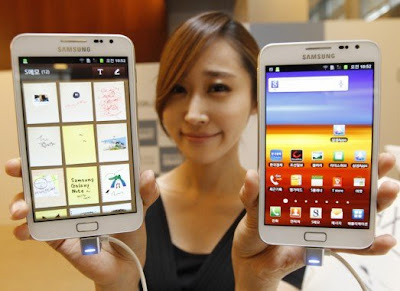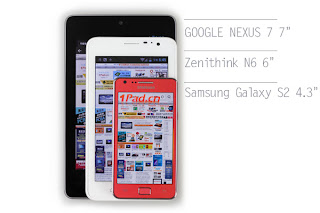 |
| Phone + Tablet = PHABLET |
Phablet is a class of smartphones
with screen sizes ranging between 5 and 6.9 inches and designed to
combine or straddle the functionalities of a smartphone and tablet.
The term itself, a portmanteau of the words phone and tablet came in
to common usage in 2008.
Phablets are typically optimized for
mobile web access and multimedia consumption—activities which are
enhanced by the larger screens. A phablet may, as in the case of
Samsung's Galaxy Note series, feature software optimized for an
integral self-storing stylus, to enhance such features as sketching,
note-taking and annotation.
 |
| Samsung Galaxy Note II = Phabelt |
In January 2013, IHS reported that
25.6 million phablet devices were sold in 2012 and estimated that
these figures would grow to 60.4 million in 2013, and 146 million by
2016.6 Barclays projected sales of phablets rising from 27 million in
2012 to 230 million in 2015.
 |
| Size Differences of each type |
In a 2013 analysis, Engadget
identified dropping screen prices, increasing screen power
efficiency, increasing battery life and the evolving importance of
multimedia viewing as critical factors in the popularity of the
phablet. Also in 2013, Forbes Magazine noted that while most clothing
cannot hold a typical tablet computer, men's clothing in particular
could and may well adapt to accommodate phablets.
Reuters called 2013, the "Year
of the Phablet."
History
Phablets were originally designed
for Asia and other emerging markets where consumers could not afford
both a smartphone and tablet as in North America. However phablets
became successful in North America too for several reasons. Many
older consumers preferred larger screen sizes on smartphones due to
deteriorating eyesight. Android 4.0 and subsequent releases were
suited to large as well as small screen sizes. While many handset
manufacturers were jumping on the trend of larger screen sizes to
suit all niches, Apple (under the direction of Steve Jobs) had long
refused to produce a device larger than the iPhone's 3.5 inches or
smaller than the iPad's 9.7 inches until late 2012. While Apple's
iPad heavily dominated the tablet market, the void in their lineup
left an opening for intermediate-sized devices such as phablets.
A pioneering device, the Streak was
an Android smartphone released by Dell in 2010. Though the Streak was
noted for its 5-inch, 800×480 pixel display (during a period where
smartphones with 3-inch displays were still relatively common) and
widescreen-optimized interface, reviewers encountered issues with its
software — including its outdated inclusion of Android 1.6, an
operating system that wasn't optimized for the larger screen. The
device was commercially unsuccessful.
 In October 2011, Samsung first
released its own phablet in selected regions, known as the Galaxy
Note. The Galaxy Note, with a 135 mm (5.3 in) screen, is sized
between smartphones such as the Galaxy S II and the Galaxy Tab
tablet. PC World Australia opined that Samsung Galaxy Note was too
big to be a true mobile phone, citing the difficulty of using it
single-handed. Techradar questioned the Galaxy Note's marketability
as users could store it in a small pocket and that the device looked
ungainly when held against their faces while conversing. GigaOM hails
it as a pioneer in a new market segment, despite the similar but
unsuccessful Dell Streak, combining the best features of both device
types. Pocket-lint has remarked that Galaxy Note showed potential as
a games console. Despite considerations about its size, the Galaxy
Note received positive reception for its stylus functionality, the
speed of its 1.5 GHz dual-core processor, and the advantages of its
high resolution display for web browsing and multimedia (most
flagship smartphones at the time such as the Galaxy S II only had a
WVGA (800 x 480) display). While the Samsung Galaxy Tab 10.1 did not
fare well against the iPad 2, the Galaxy Note was a commercial
success; Samsung announced in December 2011 that the Galaxy Note had
sold 1 million units in less than two months, one of the biggest
successes for a non-Apple tablet that year. The company soon
announced the impending U.S. release of a Galaxy Note with 4G LTE
support in February 2012, and by May 2012 the Galaxy Note received an
update from Android 2.3 to Android 4.0 which was better suited to its
large screen size. In August 2012, Samsung announced that they had
sold 10 million units of the Galaxy Note worldwide in the past nine
months. The Galaxy Note received a follow-up in September 2012, the
Samsung Galaxy Note II. The Note II uses a 1.6 GHz quad-core
processor, a 5.55-inch screen, and also includes the ability to run
two applications at once in a split-screen view. Sales of the Galaxy
Note II outpaced the original model, selling 5 million units
internationally in just two months of availability.
In October 2011, Samsung first
released its own phablet in selected regions, known as the Galaxy
Note. The Galaxy Note, with a 135 mm (5.3 in) screen, is sized
between smartphones such as the Galaxy S II and the Galaxy Tab
tablet. PC World Australia opined that Samsung Galaxy Note was too
big to be a true mobile phone, citing the difficulty of using it
single-handed. Techradar questioned the Galaxy Note's marketability
as users could store it in a small pocket and that the device looked
ungainly when held against their faces while conversing. GigaOM hails
it as a pioneer in a new market segment, despite the similar but
unsuccessful Dell Streak, combining the best features of both device
types. Pocket-lint has remarked that Galaxy Note showed potential as
a games console. Despite considerations about its size, the Galaxy
Note received positive reception for its stylus functionality, the
speed of its 1.5 GHz dual-core processor, and the advantages of its
high resolution display for web browsing and multimedia (most
flagship smartphones at the time such as the Galaxy S II only had a
WVGA (800 x 480) display). While the Samsung Galaxy Tab 10.1 did not
fare well against the iPad 2, the Galaxy Note was a commercial
success; Samsung announced in December 2011 that the Galaxy Note had
sold 1 million units in less than two months, one of the biggest
successes for a non-Apple tablet that year. The company soon
announced the impending U.S. release of a Galaxy Note with 4G LTE
support in February 2012, and by May 2012 the Galaxy Note received an
update from Android 2.3 to Android 4.0 which was better suited to its
large screen size. In August 2012, Samsung announced that they had
sold 10 million units of the Galaxy Note worldwide in the past nine
months. The Galaxy Note received a follow-up in September 2012, the
Samsung Galaxy Note II. The Note II uses a 1.6 GHz quad-core
processor, a 5.55-inch screen, and also includes the ability to run
two applications at once in a split-screen view. Sales of the Galaxy
Note II outpaced the original model, selling 5 million units
internationally in just two months of availability.
LG subsequently released the Optimus
Vu with a 5-inch display using a 4:3 aspect ratio — which was
considered an unusual aspect ratio for a smartphone screen. In late
2012, HTC released the J Butterfly (known in the U.S. on Verizon as
the HTC Droid DNA), which included a quad-core 1.5 GHz processor, and
was one of the first smartphones to utilize a 5-inch 1080p display.
Despite its screen size, HTC does not officially consider the device
a phablet.
Other large-screen devices and
phablets were unveiled at the 2013 Consumer Electronics Show,
including the Sony Xperia Z (which also uses a 5-inch 1080p display),
and the Huawei Ascend Mate—which notably incorporates a 6.1-inch
display, marketed as "the largest screen ever used on a
smartphone." At the 2013 Mobile World Congress. To date only
Android devices are found in the Phablet form factor.
References
- "The Rise of the Ever-Expanding Smartphone Screen". Engadget, Distro Issue 79, p. 50, Jon Fingus.
- Phablets Are a Niche, Not a Fad, http://techland.time.com/, Jared Newman, April 02, 2013
- "Is the Market Ready for a Phablet?", Forbes, 7 February 2012, retrieved 2012-08-15
- Enter the Phablet: A History of Phone-Tablet Hybrids, pcmag.com, Sasha Segan, February 13, 2012
- Banerjee, Ankit (16 May 2012). "The rise of the Phablet". Android Authority. Retrieved 2012-08-15.
- "Shipments of 'phablets,' or large smartphones, to double in 2013". Los Angeles Times. Retrieved 18 January 2013.
- Will Making An iPhone Phablet Hurt Apple More Than It Will Help?, Forbes.com, Haydn Shaughnessy, February 5, 2013
- Will Making An iPhone Phablet Hurt Apple More Than It Will Help?, Forbes.com, Tom Warstall, May 27, 2013
- Handset makers scurry to join Year of the Phablet, Reuters.com, Jeremy Wagstaff and Lee Chyen Yee, Jan 7, 2013
- Elgan, Mike. "Rise of the 'phablet'". Computerworld. Retrieved 18 January 2013.
- "Will 2013 be the year of the phablet as phone screens grow bigger?". Reuters.
- "Dell Streak: A Smartphone With a Tablet Heart". PC World. Retrieved 18 January 2013.
- "Samsung announces Galaxy Nexus and Note roll-out schedules". GSMArena. 2011-10-27.
- "Samsung Galaxy Note Android phone". PC World Australia. Retrieved 2011-12-04.
- Dan Grabham (2011-09-01). "Hands on: Samsung Galaxy Note review". techradar.com. Retrieved 2011-09-27.
- Kevin C. Tofel (2011-11-10). "Can Samsung’s 5.3″ Galaxy Note bridge phone and tablet use?". GigaOM. Retrieved 2011-12-04.
- Rik Henderson (2011-11-03). "Samsung Galaxy Note review". pocket-lint.com. Retrieved 2011-12-04.
- "Samsung Galaxy Note review". The Verge. Retrieved 18 January 2013.
- "Samsung Galaxy Note Review". CNET. Retrieved 18 January 2013.
- Mat Smith (2011-12-29). "1 million Galaxy Notes shipped worldwide, US fans throw money at their screens". Engadget. Retrieved 2013-01-17.
- "Samsung: 10M Galaxy Notes sold in nine months". CNET. Retrieved 18 January 2013.
- "Multi-window update comes to AT&T Galaxy Note II starting today". Boy Genius Report. Retrieved 18 January 2013.
- "Samsung Galaxy Note II Tops 5 Million in Sales". PC Magazine. Retrieved 18 January 2013.
- "HTC Droid DNA review". Engadget. Retrieved 18 January 2013.
- Zeman, Eric. "HTC Droid DNA Takes On Smartphone Rivals". InformationWeek. Retrieved 18 January 2013.
- "Ten smartphones with tablet ambitions."




No comments:
Post a Comment